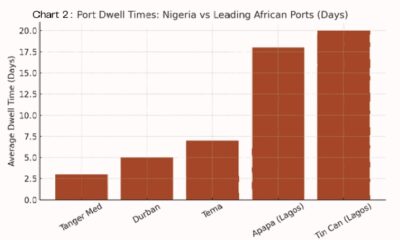Business
BACITI Advocates Market Shift for Nigerian Exporters
Nigerian agricultural and manufacturing SMEs that have carved out a market in the U.S.now face a price disadvantage.

The Bashir Adeniyi Centre for International Trade and Investment (BACITI) says that Nigerian fertilizers manufacturers and industrial goods had better consider exporting regionally under the AfCFTA .
BACITI also urges the Nigerian Export Promotion Council (NEPC) and Small and Medium Enterprises Development Agency of Nigeria (SMEDAN) to help exporters cope with the tariff’s cost through rebates, tax breaks, or low-interest loans to affected exporters.
BACITI , in its Economic Insight April 2025, noted that the U.S. tariff will hit Nigeria’s non-oil export sector hardest.
Said the report: ” Many African countries rely on preferential access to the U.S.market under AGOA (African Growth and Opportunity Act), which granted duty-free treatment to thousands of African exports.African manufacturers who invested with AGOA preferences in mind are now at risk.
Textiles, leather, and agro-processing exports from countries like Kenya,Ethiopia, Ghana, Lesotho, and Nigeria may now face 10–14%tariffs, rendering the uncompetitive.
This could lead to job losses in export zones and industrial park.
Nigerian agricultural and manufacturing SMEs that have carved out a market in the U.S.now face a price disadvantage.
Niche products like Nigerian cocoa butter, dried fruits, or textiles and apparels which entered the U.S. duty-free will become costlier and uncompetitive.
Fertilizer makes up 2–3% of Nigeria’s exports to the U.S. A 10-14% tariff on fertilizer could lead U.S. buyers to seek cheaper suppliers, thus Nigerian producers might lose that market or have to accept lower net prices.
While crude oil is less likely to be directly impacted by the new tariffs, the broader uncertainty stemming from the ongoing trade war is likely to exert downward pressure on global oil prices, thereby affecting Nigeria’s export revenues and fiscal stability.
Indirect macro impact via oil prices: fallin oil prices due to slow global trade and economic uncertainty.
This would further reduce Nigeria’s export earnings and government revenue. A $10 drop in oil price, for example, costs Nigeria billions in export earnings.
Fiscal and FX pressures: A decline inNigeria’s export earnings would reduce dollar inflows, placing pressure on the naira.
In times of global uncertainty or trade wars, investors often retreat from riskier markets. As a result, Nigeria could face capital outflows, further currency depreciation, and rising inflationary pressure.”
Business
BUA Group’s Long Service Awards: Rabiu Splashes N30bn on Staff (Video)
Five employees received N1 billion ($691,000) each, while another five were awarded N500 million ($345,000). Several others went home with N100 million ($69,000), and dozens more received sums ranging from N5 million ($3,450) to N20 million ($13,810), ensuring the rewards extended beyond senior staff and reflected the breadth of the workforce.

•Abdul Samad Rabiu
Abdul Samad Rabiu, the Chairman of BUA Group, on Saturday, Dec. 13, 2025, shared $20.7 million (about N30 billion )in cash rewards to staff for their long -service and loyalty across the conglomerate.
The payouts were announced at the BUA Night of Excellence Long Service Awards held at Eko Hotel & Suites in Victoria Island, Lagos.
The annual event, which brought together staff across BUA Group and its subsidiaries, was designed to recognize years of service, loyalty and day-to-day contributions that often go unnoticed outside company walls.
At the ceremony, Rabiu approved cash awards spanning multiple levels of the organization.
Five employees received N1 billion ($691,000) each, while another five were awarded N500 million ($345,000). Several others went home with N100 million ($69,000), and dozens more received sums ranging from N5 million ($3,450) to N20 million ($13,810), ensuring the rewards extended beyond senior staff and reflected the breadth of the workforce.
The awards build on a pattern that employees say has become familiar at BUA.
See video below:
Business
GTCO Unveils First-Ever Holiday Edition of Food & Drink Festival, Scheduled for December 20–21, 2025

Guaranty Trust Holding Company Plc (GTCO Plc) has launched the inaugural Holiday Edition of its renowned GTCO Food & Drink Festival, Africa’s largest culinary event.
The two-day festival is scheduled for December 20 and 21, 2025, at the GTCentre in Oniru, Victoria Island, Lagos.
This special edition marks a festive expansion of the annual festival, blending African culinary excellence with family-oriented holiday experiences and support for small businesses.
Unlike previous editions, it shifts focus from chef masterclasses to immersive attractions tailored for the holiday season.
Segun Agbaje, Group Chief Executive Officer of GTCO Plc, highlighted the event’s significance: “The GTCO Food & Drink Festival is a powerful platform that aligns with our mission to fuel enterprise, promote African creativity, and connect communities through meaningful lifestyle experiences.
The Holiday Edition gives us an exciting opportunity to celebrate the festive season while supporting thousands of food entrepreneurs who form the backbone of our economy.”
Record-Breaking SME ParticipationTrue to its commitment to empowering local businesses, GTCO continues its free vendor participation model.
For this edition:
– Over 4,000 applications were received.
– 213 Nigerian-owned food SMEs were selected—nearly double the number from recent editions.
– Vendors will offer diverse, affordable culinary options, providing a high-traffic platform to boost visibility and sales during the holidays.
The surge in participation highlights the festival’s role in driving SME growth and inclusive economic development.
The 2025 Holiday Edition introduces tailored attractions:-
**Christmas Village**: A curated marketplace with handcrafted gifts, seasonal delicacies, artisanal products, and holiday entertainment.
– **Large Children’s Play Zone**: Immersive games and activities for families.
– **Street Food Hub**: Showcasing Nigeria’s vibrant street food diversity.
– **Live Entertainment**: High-energy DJ sets from top Nigerian performers.
The event aligns with GTCO’s corporate social responsibility goals, promoting community impact, SME support, and Nigeria’s creative economy.
Admission is free and open to the public, emphasizing accessibility to world-class experiences.
For more details, visit the official site at [foodanddrink.gtcoplc.com](https://foodanddrink.gtcoplc.com/).
Business
BOI, NCGC sign N10bn loans for women in business
BOI said that the programme would support women-led enterprises across manufacturing, ICT, digital marketing, ecommerce, healthcare, education, renewable energy, processing, waste management, and the creative industries.

• Image of a business woman/ BOI
Nigeria’s push for inclusive economic growth gained momentum on Wednesday as the Bank of Industry (BOI) and the National Credit Guarantee Company (NCGC) launched a N10 billion loan guarantee programme aimed at improving access to finance for women-owned businesses.
The agreement, signed through a Memorandum of Understanding (MoU) in Abuja, represents one of the major gender focused credit support initiatives introduced in recent years.
The BOI Managing Director, Dr Olasupo Olusi and the Managing Director of NCGC, Mr Bonaventure Okhaimo, signed the MoU on behalf of their respective institutions.
The scheme, known as GLOW, meaning Guaranteed Loans for Women, provides for a 25 per cent guarantee by NCGC on BOI loans.
This arrangement is expected to reduce lender risk and create easier access to affordable credit for women entrepreneurs at concessionary interest rates, the two organisations said.
BOI said that the programme would support women-led enterprises across manufacturing, ICT, digital marketing, ecommerce, healthcare, education, renewable energy, processing, waste management, and the creative industries.
Olusi said the initiative was designed to address long-standing barriers that prevent women from accessing growth capital.
He said GLOW was structured to offer concessionary pricing at seven per cent, flexible collateral options and capacity building support, noting that these measures were intended to help close gender financing gaps within the MSME sector.
-

 News2 days ago
News2 days agoBayelsa deputy gov Ewhrudjakpo dies at 60
-

 News3 days ago
News3 days agoDangote Launches N1trn Education Fund to Support 1.3m Students
-

 News2 days ago
News2 days agoJUST IN: Supreme Court Reinstates Death Sentence for Maryam Sanda, Overrides President’s Pardon
-

 News1 day ago
News1 day agoBotswana, Nigeria Explore Deeper Collaboration in Livestock Development (Photos)
-

 Business1 hour ago
Business1 hour agoBUA Group’s Long Service Awards: Rabiu Splashes N30bn on Staff (Video)
-

 Business1 day ago
Business1 day agoGTCO Unveils First-Ever Holiday Edition of Food & Drink Festival, Scheduled for December 20–21, 2025
-

 Business2 days ago
Business2 days agoBOI, NCGC sign N10bn loans for women in business
-

 Sports22 hours ago
Sports22 hours agoFans vandalise Indian stadium after Messi’s abrupt exit










